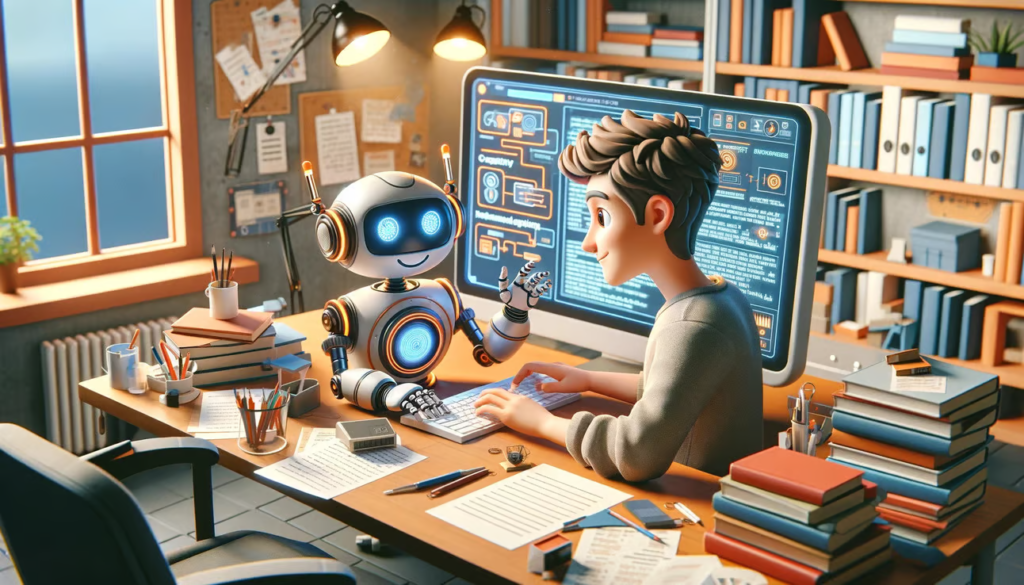AI writing tools are causing a lot of talk in the writing world. When tools like ChatGPT, Gemini, or Claude,… appeared, many writers became worried. These programs can create articles, essays, and stories quickly, which made writers and publishers think, “Are we going to lose our jobs? Would these machines take over? Would humans even be needed anymore?”
Some big companies started looking for ways to stop AI content from being used. Smaller writers and publishers were scared that cheap, computer-made content would take over the market. The big question is still hanging around: Will AI replace writers, or can we find a way to work with it and still keep our jobs?
The Reality of AI Writing Tools

At first, it looked bad – AI tools like ChatGPT seemed like they were going to replace writers faster than a pizza delivery app. It could crank out a 1000-word essay before you finished your morning coffee. But then, people started to see the truth, AI writing is fast, but it has limits.
Yes, AI can write a lot of text quickly, but the quality is usually basic. It gets the facts straight, but there’s no creativity, no soul. It feels like reading a machine’s work, not a person’s. And guess what? Google noticed too. As AI content started filling up search results, Google updated its algorithm to prefer content that shows real human effort, like actual research and expertise.
So, here’s the deal: AI can’t fully replace human writers, at least not yet. Writers can use these tools to draft content quickly, but the heart of good writing still needs the human touch. AI handles the boring stuff, and we humans get to focus on what really matters – making the content interesting.
How AI Writing Tools Help Writers Get More Done

One huge benefit of using AI writing tools is that they make the whole writing process faster. Let’s face it, staring at a blank page trying to come up with the first sentence is …uh. But AI gives you a jumping-off point. It’s like having a little assistant who spits out a rough draft so you can get going. Instead of starting with a blank page, writers can use AI to create the first draft. This saves time and helps get over writer’s block.
For example, if you need to write an article, you can give some prompts to ChatGPT, and it will quickly create a draft. The writer’s job then becomes editing and improving that draft, adding their personal style. This way, writers can take on more projects because they don’t need to spend as much time on each one.
For example, let’s try drafting an essay within 500 words with latest OpenAI o1-mini and see the result:
(o1-mini is available for Free in USnap)


So, AI tools don’t replace writers, they help them work faster. Writers can focus on being creative, adding their voice, and making the content interesting while letting AI handle the boring stuff.
Thinking About Right and Wrong in AI Content

Okay, so AI writing tools are great, but they’re not perfect angels. One big worry is that AI might accidentally copy someone else’s work. Since AI gathers info from all over the internet, it’s easy for it to spit out something that looks a lot like what’s already out there. That’s why it’s super important to double-check what the AI creates and make sure it’s original.
Another issue is responsibility. If AI writes something, who is responsible for it? The writer using the AI tool is still in charge. They have to check the facts, make sure the writing is correct, and avoid spreading false information. Basically, you’re still the boss – AI just helps with the grunt work.
How Writers Can Work with AI Writing Tools
So how can writers get the most out of AI? Here’s the key: learn to use it as a tool, not as a replacement. Here are some ways you can team up with AI:
1. Keep up with the latest technology: Writers who stay updated about new AI tools will have an advantage. The more you know, the better you can use these tools to make your work faster and more efficient.
2. Use AI writing tools smartly: It’s like this: if you’re a writer who refuses to use AI, it’s like trying to race with a horse while others are driving Tesla. These tools can help you with brainstorming, editing, or even improving your
3. Change your services: AI is cheap and fast, but human creativity is still more valuable. You could offer services like editing AI-generated drafts or provide premium content that’s 100% human. Show clients that while AI can do the basic stuff, you add the magic.
Check Content with AI Detectors
If you’re using AI tools to write, it’s a good idea to check your content with an AI detector. These tools tell you how much of the content sounds like it was written by a human versus a machine. If your content sounds too robotic, it might not do well in search results or with readers.
Here are 7 Best AI Content Detection Tools (Free & Paid) for you:
- 1. Content At Scale
- 2. Originality AI
- 3. Crossplag
- 4. Copy Leaks
- 5. Sapling
- 6. Smodin
- 7. Hugging Face AI Content Detector

Running AI-generated content through these detectors can help you find areas that need improvement. For example, if a sentence sounds unnatural, you can rewrite it to make it more human and easy to read.
Make AI Content Sound More Human
What makes human writers so special is their ability to connect with readers. AI can spit out words, but it can’t replicate the human experience. Here’s how you can make AI-generated content feel more relatable:
- Add personal stories: People love hearing real-life examples. AI can’t do that, but you can!
- Cut out the fluff: AI loves to repeat itself. Trim down unnecessary sections to keep things snappy.
- Use your own voice: AI might be able to write, but it can’t capture your unique style.
- Make it easier to read: Use lists, bullet points, and simple layouts to make the content more reader-friendly.
By making these small changes, AI-generated content can still feel fresh and engaging.
Always Verify Facts in AI-Generated Content
One big issue with AI tools is that they don’t always get the facts right. Since AI pulls information from all over the internet, it’s not always reliable. Writers should always double-check any claims or data the AI tool provides to make sure they’re accurate.
For example, if an AI tool gives you a statistic, don’t just accept it as fact—take a few minutes to verify it with a trusted source. This helps avoid mistakes and keeps your writing trustworthy.
Conclusion
When AI writing tools first came out, a lot of writers were scared. The idea that computers could write content so fast made people worry that human writers wouldn’t be needed anymore. But over time, it became clear that AI can’t replace human creativity.
AI tools like ChatGPT are great for getting quick drafts, but they still need human writers to add depth, emotion, and originality. Instead of seeing AI as a threat, writers should look at it as a tool that can make their work easier and faster.
So, if you’re a writer, don’t be afraid of AI. Learn how to use it to your advantage, but remember—AI can’t replace the heart and soul that only humans can bring to writing.
